by Larry Williams | Sep 16, 2013
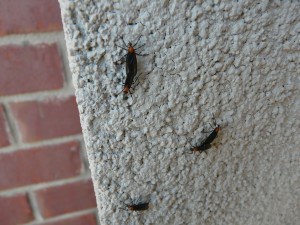
Adult lovebugs on building, Photo Credit: Larry Williams
Contrary to popular belief, lovebugs were not introduced to the state by the University of Florida. This insect is an invasive species from Central America. Lovebugs migrated from Central America, traveling through Texas and Louisiana to get to Florida. They were first reported in Florida during the late 1940s. They are now found throughout the state. Prevailing winds, vehicle traffic, sod transport, increased habitat along highways and expansion of pastures may have assisted the movement of lovebugs throughout Florida. UF researchers had nothing to do with it.
Even though it’s an interesting story, University of Florida researchers did not genetically engineer lovebugs to kill mosquitoes. A complete understanding of this insect will prove that this could not have possibly been the case. First, lovebugs do not feed on insects. They feed on pollen and nectar found in flowers. Secondly, they lack mandibles (jaws) and grasping legs to hold onto and eat mosquitoes. Thirdly, they are slow flying insects that lack speed to go after mosquitoes. Additionally, lovebugs are active during the day (usually between 10 a.m. and 4 p.m., in temperatures above 84°F). Most mosquitoes are out during the evening and night. Finally, lovebugs are only adults for a few weeks each year. The lovebug is a poor candidate to genetically engineer as a mosquito predator, even if it were possible.
Female lovebugs are attracted to UV irradiated aldehydes, a major component of automobile exhaust fumes. They may confuse these chemicals with odors emitted from decaying organic matter where the female deposits her eggs. Heat also has been shown to attract lovebugs and may be another reason for their abundance along highways.
Lovebug larvae feed on decaying plant material, assisting with converting plant debris into organic components that can again be used by the growing plants.
Adult lovebugs are active during late April and May and again August and September. Each flight lasts for a four to five week period.
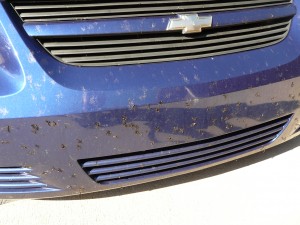
Lovebugs splattered on car, Photo Credit: Larry Williams
Even though lovebugs can be a problem as they splatter on our automobiles, be thankful that they don’t bite, sting or hang around all year.
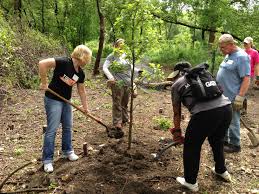
by | Sep 16, 2013
While the recently passed Labor Day is often is touted as the traditional “end of summer,” according to the calendar, fall officially will begin with the fall equinox on Sept. 22nd at 4:44 EDT. In north Florida, however, we know good and well that our summer season extends a good bit longer.
Still, even if it just feels right, there is something going on now. When you walk out in the morning, the air feels just a bit more comfortable. The days are getting shorter, and that is beginning to have an effect. Perhaps it’s just wishful thinking, but if you squint just right, you can ALMOST see the end of our long and brutally hot summer.
The word “fall” commonly conjures up images of harvest, falling leaves, the end of the growing season and the beginning of dormancy leading into winter. For gardeners in North Florida, however, the traditional fall period is not a time of winding things down in the garden or even landscape but of revival and renewed effort. It’s a time when we finally can get back into outside and enjoy ourselves as the debilitating heat of summer starts to lose its grip on the weather.
For the next couple of months we will experience a gradual shift to milder weather. There will be cool spells followed by decidedly hot, summer-like weather, but as we move into late October, cooler weather will begin to dominate the scene. Not until mid-to late November do we generally experience the nippy cold weather and changing leaves that tell us, yes, indeed, fall has finally arrived.
One thing you that you might notice that may surprise you may be an increase of vigor in your warm-season bedding plants in September. Even heat-tolerant flowers do not always look their best in August.
Since shorter days mean fewer hours of intense heat, even though the daytime highs may stay about the same, plants begin to experience less stress. This encourages a “second wind”, if you will, in the flower garden that may last well into October or early November. Given this, consider cutting back some of your summer bedding plants and flowers that have grown tall and leggy over the just passed long growing season. This should be done in by the second or third week in September at the latest – and generally involves cutting plants back about one-third to one-half their height.
While you’re at it, it might be a good idea to impose some order on those overgrown flower beds. In addition to cutting back, groom plantings to remove dead flowers and unattractive foliage.
If plants are leaning or have fallen over onto nearby neighbors, prop them up or stake them so they will stand upright. Just about every year at this time I find the remains of some unfortunate plant that was overwhelmed when larger, more vigorous, nearby plants leaned over it.
In addition, if you haven’t done so already, gently trim your everblooming rose bushes, including such popular groups as Hybrid Teas, Grandifloras, Floribundas, Miniatures, Teas, Polyanthas, Bourbons, Chinas and English roses, to name just a few. This should be a very light trimming, little more than deadheading, since the main pruning of everblooming types is done in mid February. On the other hand, keep in mind that many old-fashioned climbers, ramblers, Lady Banks roses and some bush roses that bloom heavily only in spring to early summer will bloom next year on the growth they made this summer. Those roses should not be cut back at all now.
Even though you can get back into the garden to work, it is still too early to plant hardy trees, shrubs, ground covers and vines in the landscape. Temperatures in the 80s and 90s likely will be common in September, and that is still too stressful for new plantings. Wait at least until the cooler weather of October, since the ideal planting season for hardy trees, shrubs and ground covers really is from November through February. And for those that like to plant pecan trees, these are often done in bare root when the trunk of the tree is about the size of a pencil. These MUST be done when completely dormant or you will not have a successful outcome.

While Fall is for Planting, be sure that you don’t start too early!
Keep in mind that even though they will begin to show up in area nurseries this month, it is also is too early to plant cool-season bedding plants. Even if you have an area where your summer flowers have finished and have been removed, it is still too hot to plant most cool-season bedding plants. Instead mulch the area now and wait until the reliably cooler weather of October or November before you plant your bedding plants.
Spring-flowering bulbs, such as tulips and daffodils, become available this month, but there is absolutely no hurry to plant them. Purchase them if you like while the selection is good, but wait to plant your spring flowering bulbs from mid-October through early December.
Keep in mind that insects and diseases stay active through the fall, so continue to control any pest problems with timely applications of the proper material. In addition, don’t forget, now as always, water well during dry periods, and you should have an excellent crop of flowers in October through November.
I guess if you think about it, it’s best to say that Labor Day really marks that time in north Florida when we can anticipate the soon-to-arrive milder weather and look forward to enjoying the delights of gardening over the next few months. When the fall equinox arrives later this month, don’t get carried away. For us, summer will still be lingering for a little while longer.
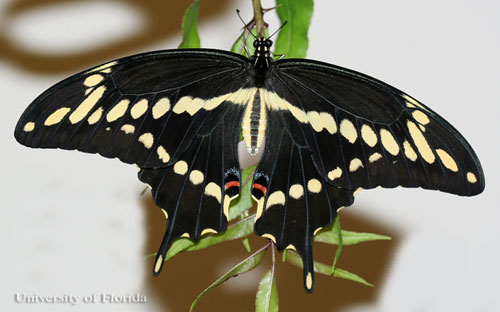
by Alex Bolques | Sep 2, 2013

Gardeners that have Satsumas, commonly known as orange mandarin (Citrus reticulate), probably have experienced a caterpillar called Orangedog. It is a chewing insect that feeds on citrus foliage including Satsuma and a few other plant species. The caterpillar is dark brown with creamy-white, mottled markings and is the larval stage of the giant swallowtail (Papilio cresphontes). It is a striking, wonderfully “exotic”-looking butterfly that is very abundant in Florida.
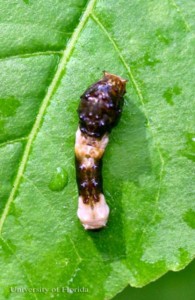
Young larva of the giant swallowtail, Illustrating bird dropping mimicry.
Credit:
Donald Hall, University of Florida
Many who have encountered the caterpillar for the first time describe them as looking similar to bird droppings. They can grow up to 1.5 to 2 inches in length and are the larval stage of the adult giant swallowtail butterfly. Established Satsuma trees can easily withstand the loss of a few leaves by Orangedog feeding. Small or newly planted Satsumas can be infested with numerous Orangedog Caterpillars on occasion, especially a single tree growing in a landscape.
A simple control measure consists of finding and crushing eggs and larva (GH-026). Bt, a biological control for most caterpillar species, is effective but should rarely be used since the beauty of this butterfly far outweighs the damage caused by them.
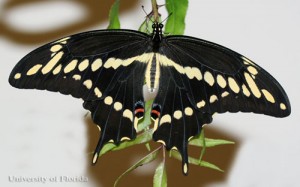
Adult giant swallowtail, with wings closed.
Credit:
Donald Hall, University of Florida
.
by Beth Bolles | Aug 23, 2013
We often consider the end of summer a time when nuisance insects are decreasing in numbers, but there is one insect that is reaching peak numbers at this time of year. The Stable Fly or Dog fly, Stomoxys calcitrans, can occur at all times of the year, but populations are heaviest in late Summer through early Winter along the Gulf Coast.
Resembling the common house fly, stable flies are persistent pests in their search for a blood meal. They have a painful bite due to specialized mouthparts that resemble sharp thorns that rasp the skin. Luckily, most people do not have an allergic reaction following a bite.
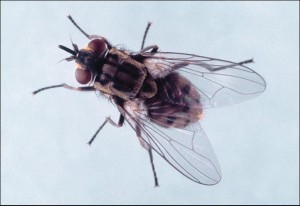
Stable flies breed in many types of moist or decaying vegetation, including seaweed deposits along the beach. Each female can lay about 500 eggs and the typical fly maggots feed in the vegetation before pupating into the adult. The entire life cycle takes several weeks.
Spraying a pesticide to control adult stable flies outdoors is not a practical option for homeowners. Rather, control methods should be directed at their breeding sites to reduce numbers. This includes allowing manures, plant debris, or crop residues to dry quickly by spreading them thinly over an area or composting them properly.
Following hurricane events, local agencies may manage stable fly populations with pesticides, but these flies do not often warrant the use of such limited resources for control.
For more information, consult this UF / IFAS publiction about the Stable Fly.
by Blake Thaxton | Aug 19, 2013
It is that time of year where mysterious webs have invaded pecan trees throughout the Southeast United States. This is definitely the case in the panhandle of Florida. Many have called into the extension office asking for identification of the web mass in their pecan trees. It is the Fall Webworm that has made a home in the pecan tree this fall.
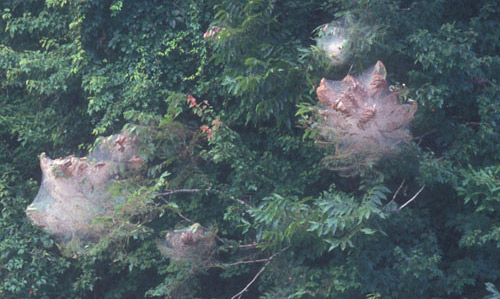
Photograph by James Castner, University of Florida.
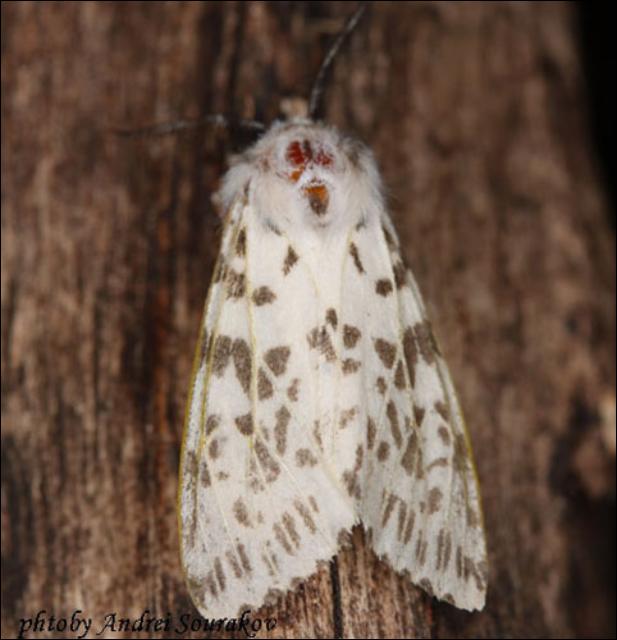
Photograph by Andrei Sourakov, University of Florida.
Fall Webworm
The adult fall webworm is a moth that is bright white in color and may have darker spots on its wings. The larvae of the moth are what lives in the tent web masses. Immediately when the larvae webworm hatches out of the eggs it begins to create its webs around foliage in which it will feed on.
Damage
The damage cause by the feeding of the larvae on the pecan trees is isolated to the leaves and they will not eat the nuts. If Defoliation is severe enough it can reduce the current years crop and the following years crop. Several years of defoliation can lead to death of the tree but this is not likely. Obviously the webs are ugly as well and if the tree is not only a producer of pecans but also functioning as an attractive shade tree in a ornamental since this can be a problem.
Control
In most commercial pecan production settings webworms are not very prevalent because of the spray programs implemented. For residential settings the best solution is to manually prune them out because of the lack of proper spray equipment to cover the entire tree. If the problem is bad enough call your local extension agent to get recommendations on products that could be used.
Sources:
Andrei Sourakov and Thomson Paris (2011, April) Fall webworm,Hyphantria cunea (Drury) (Insecta: Lepidoptera: Arctiidae: Arctiinae). Retrieved from http://edis.ifas.ufl.edu/pdffiles/IN/IN87800.pdf
Michael J. Hall. Fall Webworm. Retrieved from http://www.lsuagcenter.com/NR/rdonlyres/68665E57-A2F4-4030-A4E6-55821DCFBDD6/16783/FallWebworm_sheet_.pdf
by Larry Williams | Aug 12, 2013
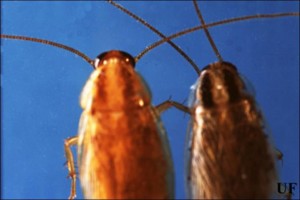
German cockroach (left), Asian cockroach (right). Credit: Dina L. Richman, University of Florida
When people first see Asian cockroaches they may think they are seeing little flying moths. Or they may believe they are seeing German cockroaches because the two species look similar. Keen observation will indicate that there are differences, particularly in behavior.
In appearance, both German and Asian cockroach adults are about 5/8 inch long and are brown in color with two darker parallel bands running lengthwise behind their head. But unlike German cockroaches, Asian cockroaches are strong fliers with sustained flights of at least 120 feet. As a person is watering a mulched plant bed with a hose, the water disturbs the roaches and they quickly fly out of the mulch, resembling little moths. Or home gardeners may see them flying out of the lawn during mowing.
German cockroaches prefer to live indoors and are a major household pest as a result. Asian cockroaches prefer to live outside in mulched beds, compost piles and lawns. Their numbers can be high with populations of 30,000 to 250,000 per acre.
They become active at sundown and are attracted to lights. They often fly inside through any opening in a house such as lighted doorways or windows. Once inside, they fly to and crawl on illuminated television or computer screens and walk on walls while lights are on during the evening. This is when people believe they are seeing a German cockroach invasion in their house, but German cockroaches do not fly.
Many people become upset when they see Asian roaches inside their home. The good news is, however, that indoor infestations are rare occurrences.
Asian cockroaches are susceptible to insecticides but they are difficult to control because of their abundant population and their ability to fly considerable distances.
Because they can fly 120 feet or more in a single flight, large areas around a home require treatment. And cockroaches in surrounding untreated areas may result in re-infestation.
Residual sprays around the perimeter of structures are usually unsuccessful because of numerous infested areas in adjacent lawns, mulch and wooded areas. Adults enter homes through windows and doorways and immediately fly to walls, avoiding baseboards and other typical areas normally treated for German cockroaches.
Best control has been attained by using insecticide baits (labeled for roach control) in infested areas outdoors.
For additional information on Asian cockroaches and their control, contact your local University of Florida / IFAS Extension Office or Pest Control Operator.










